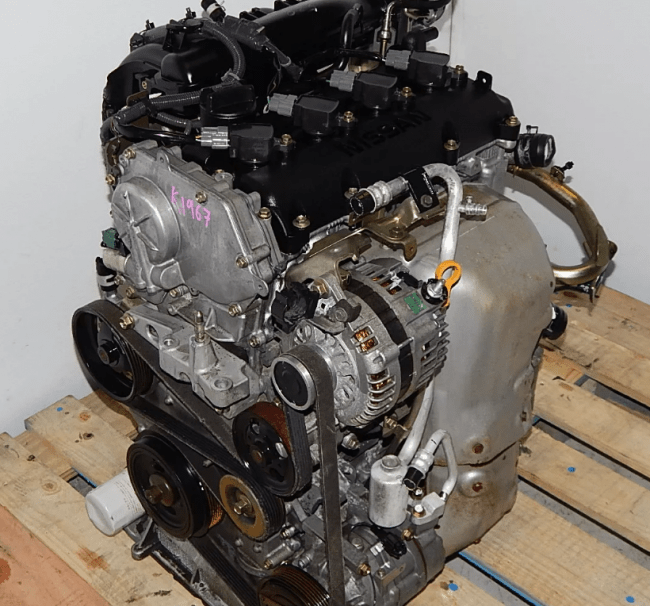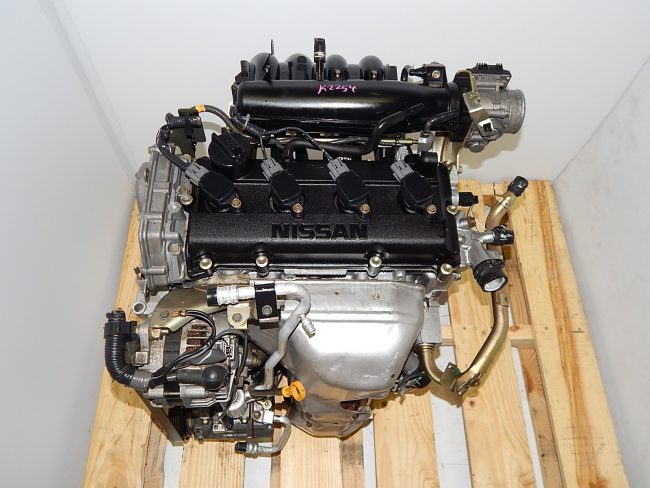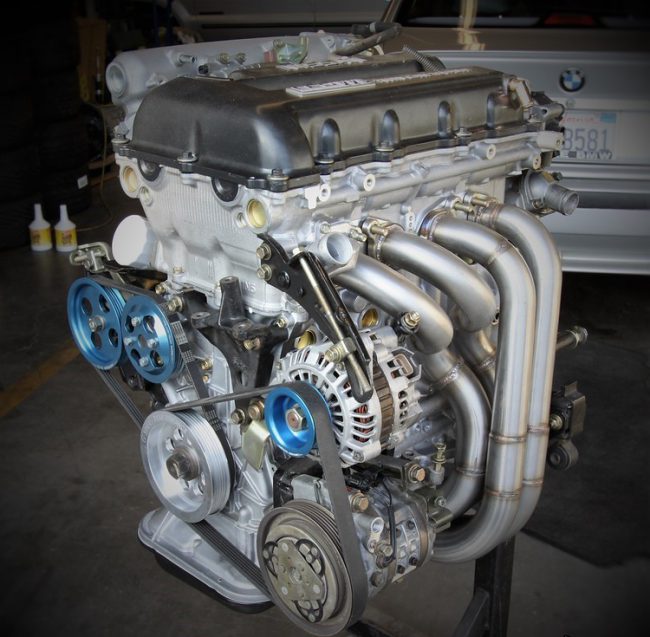
Nissan X-Trail engines
Content
The first generation Nissan X-Trail was developed in 2000. This compact crossover was the second Japanese manufacturer's answer to the super-popular Toyota RAV4 crossover. The car turned out to be no less popular than a competitor from Toyota and is still being produced to this day. Now the third generation of the car is on the assembly line.
Next, we will consider in detail each of the generations and the engines that were installed on them.
First generation

As mentioned above, the first generation of the crossover appeared in 2000 and was produced for 7 years, until 2007. X-Trail was equipped with 5 power units, 3 petrol and 2 diesel:
- Gasoline engine with a volume of 2 liters, 140 hp. Factory marking QR20DE;
- Gasoline engine with a volume of 2,5 liters, 165 hp. Factory marking QR25DE;
- Gasoline power unit with a volume of 2 liters, a power of 280 hp. Factory marking SR20DE / DET;
- Diesel engine with a volume of 2,2 liters, 114 hp. Factory marking YD22;
- Diesel engine with a volume of 2,2 liters, 136 hp. Factory marking YD22;
The second generation

Sales of the second generation of the Japanese crossover began at the end of 2007. The number of power units in the car has decreased, there are now 4 of them, while only two diesel engines were new. The forced 2-liter SR20DE / DET engine with a power of 280 hp, which was installed on cars for Japan, was no longer installed in the second generation.
In 2010, the SUV has undergone a slight restyling. However, the list of power units at X-Trail has not changed.
List of second generation Nissan X-Trail engines:
- 2 liter petrol engine, 140 hp. Factory marking MR20DE/M4R;
- Gasoline engine with a volume of 2,5 liters, 169 hp. Factory marking QR25DE;
- Diesel engine with a volume of 2,2 liters, 114 hp. Factory marking YD22;
- Diesel engine with a volume of 2,2 liters, 136 hp. Factory marking YD22;
Third Generation

In 2013, sales of the third generation began, which is produced to this day. This generation has become practically a new machine, outwardly, with the previous generation, except for the size, practically unrelated to anything. If the appearance of the car was completely new, then the list of power units has not been updated. However, it would be more correct to write, it simply decreased, diesel engines disappeared from the list of power units, and only gasoline engines remained:
- 2 liter petrol engine, 145 hp. Factory marking MR20DE/M4R;
- Gasoline engine with a volume of 2,5 liters, 170 hp. Factory marking QR25DE;
As you can see, the first power unit is completely new, but the second one was present on all three generations of the X-Trail, however, each time it was slightly modernized and added in power, albeit a little. If on the first generation a 2,5 liter engine developed 165 hp, then on the third generation it was 5 hp. more powerful.
Last year, the third generation of the Japanese SUV underwent restyling. The main difference, in addition to the appearance, which has changed relatively slightly, was the appearance in the list of power units of a 1,6-liter diesel engine with a capacity of 130 hp. The factory marking of this motor was R9M.

Next, we will analyze each power unit in more detail.
Gasoline engine QR20DE
This motor was installed only on the first generation of the crossover. And he had the following specifications:
| Years of issue | from 2000 to 2013 |
|---|---|
| Fuel | Gasoline AI-95 |
| Engine displacement, cubic meters cm | 1998 |
| Number of cylinders | 4 |
| Number of valves per cylinder | 4 |
| Engine power, hp / rev. min | 147/6000 |
| Torque, Nm / rpm | 200/4000 |
| Fuel consumption, l/100 km; | |
| city | 11.07.2018 |
| Track | 6.7 |
| mixed cycle | 8.5 |
| Piston group: | |
| Cylinder diameter, mm | 89 |
| The piston stroke, mm | 80.3 |
| Compression ratio | 9.9 |
| Cylinder block material | aluminum |
| Supply system | injector |
| The amount of oil in the engine, l. | 3.9 |
 This motor cannot be called successful. The average resource of this power unit is somewhere around 200 - 250 thousand kilometers, which, after practically perpetual motion machines of the 90s, looked like a mockery and an unpleasant surprise for fans of Japanese cars in general and Nissan cars in particular.
This motor cannot be called successful. The average resource of this power unit is somewhere around 200 - 250 thousand kilometers, which, after practically perpetual motion machines of the 90s, looked like a mockery and an unpleasant surprise for fans of Japanese cars in general and Nissan cars in particular.
The following grades of oil were provided for this motor:
- 0W-30
- 5W-20
- 5W-30
- 5W-40
- 10W-30
- 10W-40
- 10W-60
- 15W-40
- 20W-20
According to the technical manual, the interval between oil changes was 20 km. But from experience, if you follow these recommendations, the engine will go no more than 000 km, so if you want the engine to go more than the above mileage, it is worth reducing the intervals between replacements to 200 km.
In addition to the Nissan X-Trail, these power units were also installed on the following models:
- Nissan Primera
- Nissan Teana
- Nissan Serena
- Nissan wingroad
- Nissan Future
- Nissan Prairie
Gasoline engine QR25DE
This engine is, in fact, QR20DE, but with an increased volume of up to 2,5 liters. The Japanese were able to achieve this without boring the cylinders, but only by increasing the piston stroke to 100 mm. Despite the fact that this engine cannot be considered successful, it was installed on all three generations of the X-Trail, this was due to the fact that the Japanese simply did not have another 2,5 liter engine.
The power unit had the following technical characteristics:
| Years of issue | from 2001 to the present day |
|---|---|
| Fuel | Gasoline AI-95 |
| Engine displacement, cubic meters cm | 2488 |
| Number of cylinders | 4 |
| Number of valves per cylinder | 4 |
| Engine power, hp / rev. min | 152/5200 160/5600 173/6000 178/6000 182/6000 200/6600 250/5600 |
| Torque, Nm / rev. min | 245/4400 240/4000 234/4000 244/4000 244/4000 244/5200 329/3600 |
| Fuel consumption, l/100 km; | |
| city | 13 |
| Track | 8.4 |
| mixed cycle | 10.7 |
| Piston group: | |
| Cylinder diameter, mm | 89 |
| The piston stroke, mm | 100 |
| Compression ratio | 9.1 9.5 10.5 |
| Cylinder block material | aluminum |
| Supply system | injector |
| The amount of oil in the engine, l. | 5.1 |
 Like the previous power unit, it could not boast of high reliability. True, for the second generation of the crossover, the motor underwent a slight modernization, which had a positive effect on its reliability, but naturally did not increase it radically.
Like the previous power unit, it could not boast of high reliability. True, for the second generation of the crossover, the motor underwent a slight modernization, which had a positive effect on its reliability, but naturally did not increase it radically.
Despite the fact that this power unit is related to a two-liter one, it is much more demanding for engine oils. Manufacturers recommend using only two types of oils in it:
- 5W-30
- 5W-40
By the way, if someone does not know, then on the conveyor of a Japanese company, oils of their own production are poured, which can only be bought from an authorized dealer.
As for oil change intervals, here manufacturers recommend shorter intervals than its two-liter counterpart, after only 15 km. But in reality, it is better to change at least after 000 km, and ideally after 10 km.
Since this power unit was produced longer than the two-liter one, the models on which it was installed more:
- N
- Nissan Teana
- Nissan Maxima
- Nissan Murano
- Nissan Pathfinder
- Nissan Primera
- Nissan Sentra
- Infiniti QX60 Hybrid
- Nissan predicted
- Nissan Serena
- Nissan presage
- Nissan Frontier
- Nissan rogue
- Suzuki equator
Petrol power unit SR20DE/DET
This is the only power unit from the 90s that was installed on a Japanese crossover. True, "X-Trails" with it were available only on the Japanese islands and cars with this engine were not delivered to other countries. But it is quite possible that in the Far East you can meet a car with this power unit.
According to reviews, this is the best engine of those that were installed on the Nissan X-Trail, both for reasons of reliability (many consider this engine to be practically eternal) and for reasons of power characteristics. However, it was installed only on the first generation of the jeep, after which it was removed for environmental reasons. This motor had the following specifications:
| Years of issue | with 1989 on 2007 |
|---|---|
| Fuel | Gasoline AI-95, AI-98 |
| Engine displacement, cubic meters cm | 1998 |
| Number of cylinders | 4 |
| Number of valves per cylinder | 4 |
| Engine power, hp / rev. min | 115/6000 125/5600 140/6400 150/6400 160/6400 165/6400 190/7000 205/6000 205/7200 220/6000 225/6000 230/6400 250/6400 280/6400 |
| Torque, Nm / rev. min | 166/4800 170/4800 179/4800 178/4800 188/4800 192/4800 196/6000 275/4000 206/5200 275/4800 275/4800 280/4800 300/4800 315/3200 |
| Fuel consumption, l/100 km; | |
| city | 11.5 |
| Track | 6.8 |
| mixed cycle | 8.7 |
| Piston group: | |
| Cylinder diameter, mm | 86 |
| The piston stroke, mm | 86 |
| Compression ratio | 8.3 (SR20DET) 8.5 (SR20DET) 9.0 (SR20VET) 9.5 (SR20DE/SR20Di) 11.0 (SR20VE) |
| Cylinder block material | aluminum |
| Supply system | injector |
| The amount of oil in the engine, l. | 3.4 |
 This power unit uses the widest range of engine oils:
This power unit uses the widest range of engine oils:
- 5W-20
- 5W-30
- 5W-40
- 5W-50
- 10W-30
- 10W-40
- 10W-50
- 10W-60
- 15W-40
- 15W-50
- 20W-20
The replacement interval recommended by the manufacturer is 15 km. However, for long-term engine operation, it is better to change the oil more often, somewhere after 000 or even after 10 kilometers.
The list of cars on which the SR20DE was installed is quite large. In addition to the X-Trail, it was installed on an impressive range of models:
- Nissan Almera
- Nissan Primera
- Nissan 180SX/200SX/Silvia
- Nissan NX2000/NX-R/100NX
- Nissan Pulsar/Saber
- Nissan Sentra/Tsuru
- Infiniti G20
- Nissan Future
- Nissan bluebird
- Nissan Prairie/Liberty
- Nissan Presea
- Nissan Rashen
- Nissan R'nessa
- Nissan Serena
- Nissan Wingroad/Tsubame
By the way, due to the high power, the Nissan X-Trail, on which this power unit was installed, wore the GT prefix.
Diesel engine YD22DDTi
This is the only diesel power unit of those that were installed on the first "X Trail". Compared to its gasoline counterparts, it was much more reliable and significantly lower operating costs.  Among all the power units installed on the first generation of the Japanese SUV, it can be considered the best. It had the following specifications:
Among all the power units installed on the first generation of the Japanese SUV, it can be considered the best. It had the following specifications:
| Years of issue | with 1999 on 2007 |
|---|---|
| Fuel | Diesel fuel |
| Engine displacement, cubic meters cm | 2184 |
| Number of cylinders | 4 |
| Number of valves per cylinder | 4 |
| Engine power, hp / rev. min | 77/4000 110/4000 114/4000 126/4000 136/4000 136/4000 |
| Torque, Nm / rev. min | 160/2000 237/2000 247/2000 280/2000 300/2000 314/2000 |
| Fuel consumption, l/100 km; | |
| city | 9 |
| Track | 6.2 |
| mixed cycle | 7.2 |
| Piston group: | |
| Cylinder diameter, mm | 86 |
| The piston stroke, mm | 94 |
| Compression ratio | 16.7 18.0 |
| Cylinder block material | cast iron |
| The amount of oil in the engine, l. | 5,2 6,3 (dry) |
| Engine weight, kg | 210 |
The list of engine oils that can be poured into this engine is quite large:
- 5W-20
- 5W-30
- 10W-30
- 10W-40
- 10W-50
- 15W-40
- 15W-50
- 20W-20
- 20W-40
- 20W-50
The interval between oil changes, according to the technical settings of the manufacturer, is 20 kilometers. But, as is the case with gasoline power units, for long and trouble-free operation, the oil should be changed more often, somewhere, after 000 km.
The list of models on which these motors were installed, as with previous power units, is quite extensive:
- Nissan Almera
- Nissan Primera
- Nissan AD
- Nissan almera tino
- Nissan expert
- Nissan sunny
As for the Rhesus YD22, according to the owners, although it is not eternal like the engines of the 90s, it will be at least 300 km.
In conclusion of the story about this diesel engine, it must be said that Garrett turbocharged power units are installed on the X Trail. Depending on the compressor model used, two versions of this power unit are, in fact, put on the machine, with a capacity of 114 and 136 horsepower.
Conclusion
Actually, these are all the engines that are installed on the first generation of the Nissan X-Trail. If you are going to buy a used car of this brand, then it is best to take it with a diesel engine. Gasoline engines on used X-Trails will most likely end up with a depleted resource.
Actually, this concludes the story about the power units of the first generation Nissan X-Trail crossover. The power units that were installed on the second and third generations will be discussed in a separate article.

